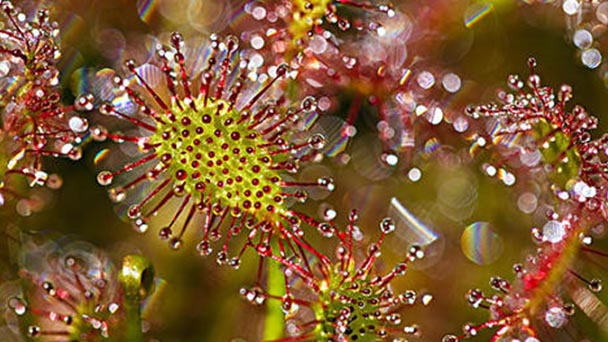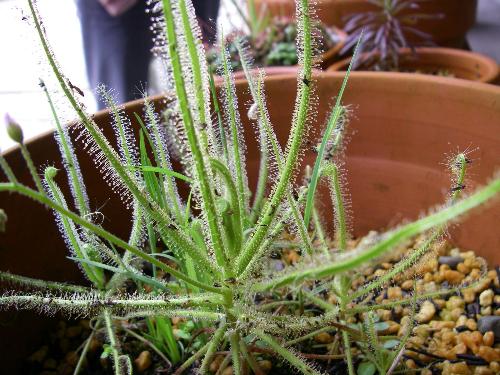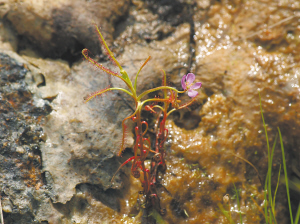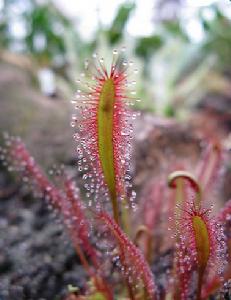Drosera indica profile
Written by Maggie
Mar 31 2021

Drosera indica is a rare insectivorous flower in the tropics, belonging to the sundew family annual herb. Drosera indica can grow up to 50 cm in height, but it is common to see new plants, each of which is no more than 10 cm. Drosera indica has a habit of growing in clusters, with many young plants growing around it.
Drosera indica grows on the edge of wet open ground or paddy field below elevation of 600 m. drosera indica was produced in Taiwan, Fujian, Guangdong, Guangxi and other provinces and coastal islands. The bright green Drosera Indica looks like its name, with long, thin leaves (hence the word "long leaves") that secrete mucus to feed on insects.
Drosera indica picture

Morphological features of Drosera indica
Drosera indica is an annual herb, sessile, 6-38 cm tall, erect or prostrate, stem covered with short glandular hairs. Leaves are alternate, pale green or red, linear, flattened, 2 -- 12 cm long and 1 -- 3 mm wide, upper leaves straight, lower leaves curved down to strut; Stipules of Drosera indica are usually absent, sparsely degenerate into hairs; Petiole and leaf blade are often indistinguishable, sometimes narrower than leaf blade, short glandular hairs or glabrous, glabrous parts 0.8-2 cm long; Leaf blade is covered with white or red glandular hairs.
Inflorescences of Drosera indica are subopposite to leaves or axillary, 6-30 cm long, with 5-20 flowers, short glandular hairs; Bracts are 1.5 -- 7 mm long, linear, covered with short glandular hairs; Pedicle of Drosera indica is 6-10 mm long, short glandular hairs; Calyx is 5-lobed to near base, lobes lanceolate or oblong, ca. 4 mm long, short glandular hairy, entire or glandular dentate; Drosera indica has 5 petals, veined, obovate or oblanceolate, ca. 6 mm, white, reddish to purplish red; Drosera indica has 5 stamens, ca. 5 mm, filaments flattened, anthers lobed longitudinally; Ovary is cylindrical, obovate or subglobose, placenta 3; Drosera indica has 3 style, each 2-lobed to near base, apically often curved inwards. Capsule is obovoid, 4-6 mm long, mericarp 3; Seed majority, fine, black, seed coat veins thickened into a honeycomb lattice.
Ecological habits of Drosera Indica
Drosera indica grows on the edge of wet open ground or paddy field below elevation of 600 m.
Drosera Indica's distribution
Drosera indica was produced in Taiwan, Fujian, Guangdong, Guangxi and other provinces and coastal islands. Drosera indica is distributed in tropical and subtropical areas of Asia, Africa and Oceania.
How to grow and care for Drosera indica
The temperature care
The minimum temperature of sowing should reach more than 15℃, and the minimum temperature of overwintering in the growing period should be above 10℃. The northern region should be overwintering in the greenhouse.
Water care
Use only rainwater, distilled water or reverse osmosis water. Drosera indica requires very pure water. Your tap water is likely to contain too much dissolved solids—minerals and salts—that may kill a Drosera indica, possibly within weeks. Always keep your Drosera indica moist, but never soggy for long, and never dry. One way to accomplish this is to water thoroughly from the top or by placing the pot in a tray of water and allowing water to soak into the medium from the bottom through the drainage hole. DDrosera indica can be kept wetter than Venus Flytraps, but it's still not a good idea to keep them too wet, especially during dormancy. When Drosera indica are very wet, they should also be warm and in the sun. Wet and cold is unhealthy (just like it is for people) and can cause fungal infections, rot and even death.
Soil care
Drosera indica must have a particular kind of soil that is poor in nutrients and slightly acidic. They will very likely die in "potting soil" or soil from your garden or yard. Their soil must be like the soil in their natural habitat: acidic and with almost no nutrients, moisture retentive but well drained. Until you learn what various types of ingredients you can have in their soil (from research on the Internet or from books, for example), it is best to use pure shagnum peat moss (no other kind of "moss") mixed with a more or less equal amount of silica sand (not beach or river or "play" sand) and/or perlite.
Sun care
Most Drosera indica do well in bright light, and in general, the more direct bright sunlight you give them, the healthier and more colorful they will be. At least 6 hours of bright, direct sunlight will produce a very healthy sundew. There are some species that are exceptions however. The Drosera indica is one sundes that does better in bright indirect light.
Fertilizer care
Although experienced growers can occasionally fertilize Drosera indica lightly using special techniques such as foliar feeding, Drosera indica will probably die when fertilized by beginner growers, for the same reason that they usually die from tap water: too many minerals and chemicals. These burn the plants' roots and kill them. Drosera indica get all the nutrition they need from the sun (through photosynthesis like any plant) and from the insects they catch. If they are healthy and if you put them outside sometimes to "hunt," they will catch insects on their own. If you'd like, you can feed them captured flies or other insects (but not meat!), but they will likely catch all they need on their own.

Seedling way
Seedling of Drosera indica should be sown and raised in a seedling box or hole tray. Seedling box or hole tray should be put in a greenhouse or a small bow shed. Seedling should not be raised in the open field.
Selection and preparation of matrix
The substrate should be relatively loose, strong water-holding capacity of the substrate, the preparation of stone, coconut bran, peat and other materials, can also be used for commercial substrate seedling.
The matrix disinfection
The substrate should be disinfected during sowing to prevent disease. The substrate should be dried in the sun and soaked with disinfectant after sowing.
Seeding rate
1 ~ 2 grains per hole.
Seeding method
Because the seeds of Drosera indica are small and inconvenient to operate, the seeds are fixed on the absorbent paper, and there is a seed in a red circle. Before sowing, cut the seeds together with the absorbent paper, and place them on the surface of the substrate with a taper.
Cover
Seeds of Drosera indica have good light, germination needs appropriate light, after sowing they do not have to cover.
Moisturizing spray
After sowing the substrate to often keep wet, usable fine mist spray water can also be soaked from the bottom of the plate, water to be disinfected, disinfectant available, strong chlorine net or 100 poison, relative humidity to maintain at 90% or so.
Shade
After sowing and seedling stage should not have strong sunlight exposure, you need to use 85 ~ 90% sunshade net.
Emergence
When the temperature and humidity are suitable, it takes about 25 days for seedlings of Drosera indica to emerge at the fastest time, and it takes about 2 months for seedlings to emerge at the slowest time.
Seedling disease prevention
Slow seedling growth should pay attention to disease prevention, available 50% carbendazim wettable powder 800 ~ 1000 times regular spray. The young Drosera indica should be protected from rain.
Bed out
Seedlings 5 cm high and then transferred into the pot for cultivation, transplanting must take mulch, planting should be a little deeper, each time than the original soil surface buried a cm deep, the best after the second transplanting and then on the pot for cultivation, seedlings strong leaves long beautiful.
Drosera indica winter care
Drosera indica can be given the same basic care year round. They do well in a very sunny window and do not need a dormancy period during the winter. Where they are native to rarely gets below 55°F, but nearly all species can stand temperatures down to freezing.
The purpose of Drosera indica
Drosera indica can be used as an ornamental novel potted plant, but is also used in warm areas to decorate bog gardens.
Drosera indica common varieties
D. capensis
D. spatulata
D. tokaiensis
D. dielsiana
D. adelae
D. binata
D. aliciae
D. regia
D. prolifera
Pygmy sundews
Woolly sundews

Latest Updated
- Benefits of Bugleweed - 7 Science-backed Health Benefits
- Bugleweed Dangers & Side Effects - Is It Poisonous?
- How to Plant Evergreen Trees - What You Should Know
- When to Plant Evergreens - Grow Guide for Evergreen Trees
- 12 Wonderful Evergreen Shrubs for Your Garden
- 12 Popular Evergreen Plants with Pictures for Beginners
- When And How To Prune A Lilac Bush Like a Pro
- How to Grow & Care for Lilac Vine (Hardenbergia Violacea)
- Japanese Lilac Tree (Syringa Reticulata) Care & Propagation Guide
- Shumard Oak Pros and Cons - What to Know
Popular Articles
- Winter maintenance of Antirrhinum Majus
- How to Grow Terminalia Mantaly Tree
- How to Grow and Care for Crossostephium Chinense
- How to grow Antirrhinum Majus in spring
- Peristeria Elata (Dove Orchid) Profile: Info & Care Guide
- Underwatered Snake Plant (Sansevieria Trifasciata) - Signs And How To Fix
- How to Care for Brazilian Jasmine Plant (Mandevilla Sanderi)
- How to Grow & Care for Graptopetalum Purple Delight in Summer
- Rosa Chinensis (China Rose): Plant Growing & Care Tips
- How to Care for Baby Sun Rose (Aptenia Cordifolia)